There’s this gag in many humorous children’s stories which almost everyone else finds hilarious and I find really troublesome. It’s when a male character dresses as a female character. This gender inversion in itself is meant to be funny. But why?
Here’s another article explaining why cis actors in trans roles is problematic.
For very young children, inversions are funny in general. Hat on the dog type gags will really tickle a three-year-old.
GENDER EXPANSIVE CHARACTERS FROM ANTIQUITY
The gender inversion story is as old as myth. Take Loki. Loki can be a cool example of the literal gender-binary-blurring of the Archetypal Trickster. As well as transforming into various animals, Loki also presents as a woman occasionally if a trick demands it, and in one famous case, does both, shifting into a female horse and becoming the mother of a magical beast. Marvel has deemed their version of Loki officially gender fluid.
In the Ancient Greek legend of the thunder god, Thor dresses as Freya and pretends to marry someone to get his hammer back. Hear this one discussed at feminist folklore podcast Femlore.
Bonnie Bullough report that cross-dressing played a prominent role in “many non-Western religious traditions and exists in the mythologies of many peoples.”. For exdample, they explain that cross-dressing practices are evident in Hinduism, where androgyny is idealized and highly valued, and similarly have a place in Islamic culture, where muslim dervishes exhibited a form of “psychic transvestism” that greatly influecned Sufi philosophy. In Myanmar, cross-dressing behaviour is interpreted in light of “animistic beliefs still ingrained in Burmese Buddhism”. Further examples of cross-dressing behaviour abound in Masai, Indian, Papua New Guinean, Madagascan, and Tahitian cultures. A particularly notable example of cross-dressing practices can be found in the history of North America, where “white explorers and missionaries in the seventeenth and eighteenth centuries found that many Native American tribal cultures recognized multiple genders, including ‘women-man’, and ‘men-women’ who took on cross-gender roles, often involving cross-dressing.
Into the Closet: Cross-Dressing and the Gendered Body in Children’s Literature and Film (Children’s Literature and Culture) by Victoria Flanagan (2007).
BINARY GENDER IS COLONIALISED GENDER
Men dressed as women in April 1451 during Cade’s Uprising to protest that, for them, the world had turned topsy turvy.
The Decolonizing Sexualities Network: a transnational collective that brings together academics, activists and artivists from across the global norths and souths for whom colonialism, coloniality and decolonization are central to the analytics, politics, experiences, and movements of gender and sexuality.
GENDER IN MEDIEVAL CHRISTIAN CULTURES
Even in Christianity, art historians have pointed out the proliferation of 14th-16th C religious images which depict Mary’s breast alongside Christ’s wound, intermingling the symbolism of milk with the symbolism of blood. Blood and milk are both associated with nourishment and a performance of maternal identity. Although we code Christ as masculine, what was Christ actually doing? Christ was like a mother figure, bleeding to give life to Christians in the same way mothers lactate to give life to babies. (In Medieval times, people thought breastmilk was a type of blood.) Sure, these are just images we’re talking about. Images are symbolic. But symbolism in art speaks to widely held concepts of the people living at that time. We know that Medieval thinks had a more fluid notion of gender identity than Christians who came after. Like Christ’s body, everyone’s body was in some ways male and some ways female.
GENDER SPECTRUMS FROM AROUND THE WORLD
Almost every culture operates under a system of patriarchy, and by increasing the binary genders to look more like the spectrum that it is doesn’t automatically elevate communities out of patriarchy: almost without exception, cishet men remain at the top of this gender hierarchy, no matter how cultures break it down. However, the following list exemplifies how so many cultures do at least recognise that gender is a spectrum, not a binary:
- North America has Two-Spirit. Identifying with masculinity and femininity, indigenous North American two-spirit people are often said to contain both male and female ‘spirits’. They’re often revered in their communities as a channel between the physical and spiritual realms.
- Samoa has Fa’afafine and Fa’afatama. Fa’afafines’ roles in society move fluidly between the traditional male and female. Fa’afatama is another fluid gender for those assigned female at birth.
- South Asia has Hijras. This third gender is centuries old. Hijras are associated with sacred powers. The name usually refers to those assigned male at birth but who don’t identify as male. In 2014, India legally recognised hijras as a third gender after they were criminalised by the British in 1871.
- Albania has Sworn Virgins. People assigned female at birth (oftentimes self-identifying women) take on the social identity of a man for life, though this is often simply a response to an oppressive patriarchy rather than a response to a person’s gender identity. (As you can probably tell from the name, Sworn Virgins are also forced taking a vow of chastity).
- Nepal has Metis. Officially recognised as a third gender in Nepal in 2007, metis have a long history in the Himalayan region. Assigned male at birth, they assume a traditional feminine appearance. Nepal set a global precedent with a third gender category on official documents.
- Indonesia has Bugis. Indonesia has for centuries seen gender as a spectrum. In addition to ‘male’ and ‘female’, Indonesia recognises three additional genders. Bugis genders include ‘calabai’ (feminine men), ‘calalai’ (masculine women) and intersex ‘bissu’ priests.
- Australian Aboriginals and Torres Strait Islanders have Brotherboys and Sistergirls. Brotherboys are people with a gender experience inconsistent with their assigned sex, with a male spirit and male roles in the community. Sistergirls are the inverse.
- Thailand has Toms, alongside about a dozen or more common gender identities. Toms are women who adopt masculine mannerisms, aesthetics and speech. Toms are often attracted to ‘dees’ – women who follow traditional Thai gender norms.
GENDER MARKERS ARE HIGHLY CONTEXTUAL AND VARIABLE
Now’s a good time to point out that expressions of gender are contingent upon era and place. The man in the image below is wearing typical men’s swimwear of the 1920s. However, a modern audience may look at the blue swimsuit and assume a man is wearing ‘women’s’ swimwear. There’s no such thing as men’s and women’s swimwear. Clothes do not have an inherent gender. Likewise, pink has only been ‘for girls’ since the 1940s.

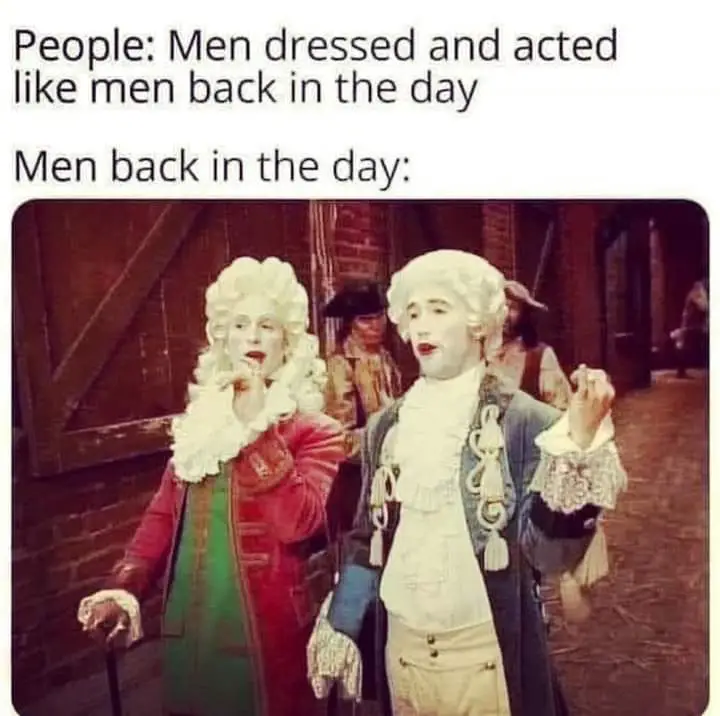


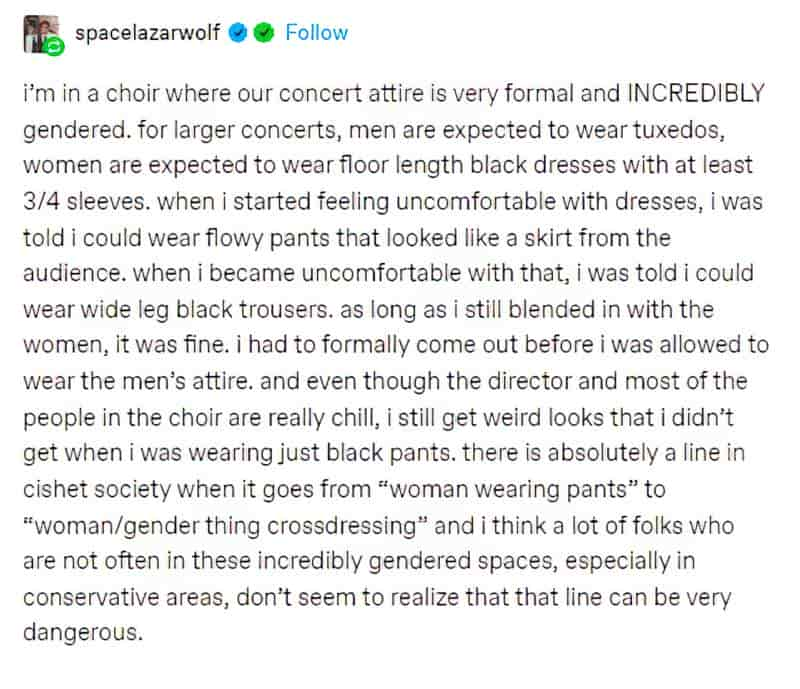
DOES GENDER INVERSION EQUAL SUBVERSION?
Artists have played with gender inversion for many decades as a way of subverting the gender binary. The question to ask: Is this gender subversion, or is it unhelpful inversion? The multi-component test for this: Is this a boy being dressed as a girl, against his will, for humiliation purposes?
My issue is not with characters who crossdress by their own volition. In fact, anything we can do to mess with the gender binary is just fine with me.
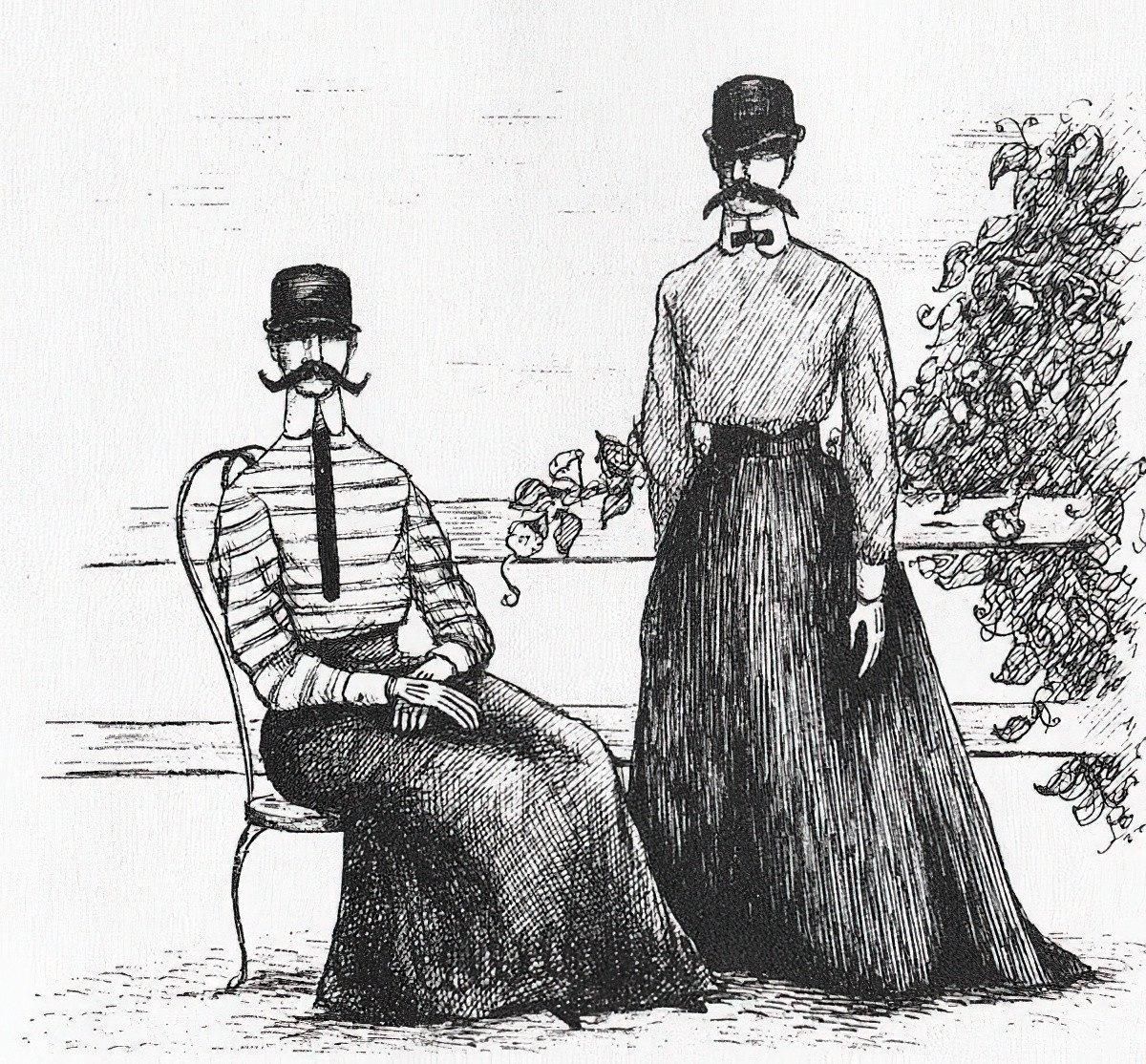
I’m not talking about the long history of girls dressed up as boys to allow girls boy-like freedom. Those are largely subverting the gender binary rather than reinforcing them.
Were it not better,
As You Like It
Because that I am more than common tall,
That I did suit me all points like a man?
Lie there what hidden woman’s fear there will,
We’ll have a swashing and a martial outside,
As many other mannish cowards have
That do outface it with their semblances.’
But this my masculine usurped attire . . .
Twelfth Night
Conceal me what I am, and be my aid
For such disguise as haply shall become
The form of my intent . . .
Disguise, I see, thou art a wickedness
Wherein the pregnant enemy does much.

Parvana is eleven when the Taliban comes to power in Afghanistan. Her father is arrested, and women are not allowed to leave the house without a male escort. Parvana must disguise herself and find work to save her family.
There’s a common difference between fictional girls-dressed-as-boys and boys-dressed-as-girls. When female characters dress as boys, they generally do so to pass as male and go on adventures. They are treated with respect and carry out tasks as well as male characters would be expected to do. This debunks gender binary stereotypes by saying that girls can do anything boys can do if given the chance. It also highlights the existence gender hierarchy by showing that girls are treated better when they shuck off their feminine accoutrements. However, when fictional male characters dress as female characters, they are almost always comically unconvincing. This works to reinforce gender binaries rather than to challenge them. (You can’t be a ‘real‘ woman unless you look and act in a certain way, unattainable to ‘natural’ men and boys.)
That said, scholars have noticed that when girls dress up as boys in stories they either die the end or return to their pre-adventure, feminine state. Sometimes these girls are ‘reintroduced into the stereotypical feminine matrix’, as Maria Nikolajeva says in Power, Voice and Subjectivity in Literature for Young Readers.

In this post I’m talking specifically about boys and men dressed up as women and girls for laughs.
To pre-empt anyone thinking at this point that jokes are just jokes, separate from the ‘real’:
Humour can be either very dependent on an escapist mindset or the very opposite. Laughter is a diversion, much like fantasy, though it also often requires an understanding of what is actually going on.
Film School Rejects
Clothing is a potent cultural symbol of gender and sexual difference, and the wearing of clothes deemed socially appropriate for the opposite sex is generally considered to be a transgressive and provocative act.
Victoria Flanagan, Into the Closet: Cross-Dressing and the Gendered Body in Children’s Literature and Film (2007).
A BRIEF HISTORY OF GENDER INVERSION
Gender inversion hasn’t always been done for laughs. When Taylor Swift dresses as a man in “The Man”, she is making points about the rules around masculinity and femininity.
Taylor Swift wasn’t the first to explore these ideas in a music video.
Gender inversion is ancient, and also a very old gag.
The British pantomime tradition has prolonged the life of the medieval diablerie, and Mother Goose, irreverently guying her betters, crossed over from the nursery and the riddle book to flourish on the boards. Significantly, Mother Goose is a drag role; like Widow Twankey or the Wicked Stepmother, she was played by a pantomime dame in the Christmas dramas and music-hall revues. The earliest piece extant to pluck her from the pages of children’s collections of tales or rhymes and put her on stage was called Harlequin and Mother Goose; or, the Golden Egg, and it blended, as the title suggests, com media dell’arte stock characters with British comic fairytale motifs. Sex reversals pointed up the magic as well as the absurdity: the name of Pulcinella, Mister Punch’s clownish ancestor from Italian masked comedy, ends in the feminine a which retains the memory of his bravest. Mother Goose triples the inversion: she is played by a man to look like a cross-dressed woman who herself looks like Pulcinella/Punch.
Marina Warner, From The Beast To The Blonde

GENDER ‘INVERSION’ RESTS UPON A BINARY NOTION OF GENDER
A binary view of gender is no longer supported by science, let alone the lived experience of many people. But in order to find gender inversions funny, the (conservative) audience must have a binary and immutable view of two genders, with strict rules applied to each. As soon as the audience understands that gender roles are fluid, and that gender is a continuum, the joke fails. A man in a dress would no longer be funny if men were permitted to wear dresses without ridicule.
Wayne’s World (attracting a teenage and early adult audience) came out in 1992.
On a surface level, this Wayne’s World gag pokes fun at the two ironic heroes for their discomfort at their own sexuality. Also, the mask almost peels off, and masks are an essential element of comedy.
But what else does this gag rely on in order to ‘work’? It relies on an implicit narratee agreement that gender transgression is shameful and humiliating. There are other victims enclosed in this joke, aside from the fictional heroes of Wayne’s World.
‘Conservative’ commentators often start with the absurd claim that telling schoolchildren about transgender identity is ‘child abuse’, then swivel into insinuations of paedophilia. Above all, we’re impostors, a cheat, a ‘travesty’ (deconstruct that), a parody of womanhood, a pretend: a pretend sister to feminists, a pretend hot date to regular guys. I expect it’s this alleged deceptiveness of trans women, along with our sexualisation, that explains why so many people in so many states of America apparently think it’s OK to chase us out of women’s toilets at gunpoint, or beat us up or rape us if they see us at the drive-in.
Sophie-Grace Chappell
GENDER INVERSION IN CHILDREN’S FILM
A recent example of gender inversion as gag can be seen in Paddington (2014), in which Hugh Bonneville attempts to pass as a cleaning lady.

In order to see the dark side, it’s necessary to consider why this is funny.
- The character Mr Brown is, by the part of the story, known to us as a stiff upper lip, well-to-do fellow who dresses in a manly suit and must earn a lot of money. He lives with his wife and two children in a very large London house. When we see him dressed as a cleaning lady, he has been stripped of his masculine stripes. He is now on the lowest rung of London’s socioeconomic ladder, and the gender switch underscores the fact. Notice how he’s not a cleaning gentleman. Notice he’s wearing pink, not blue. Femininity is presented in opposition to his masculinity as father and provider. The gag is that he couldn’t possibly stoop any lower. The invisible ideology is that a woman (doing typically woman’s work — and also underscoring that cleaning should be woman’s work) is worth less than a man.
- Children don’t look all that hard at it, of course. For a young audience, a man dressed down as a woman is like a dog wearing a hat. This scene is funny because it’s incongruous. However, there are real world consequences when children’s films stoop to using this particular gendered incongruity (as if there aren’t a million other incongruities from which to choose): We are teaching children to find transgender women funny, weird, exotic and unnatural. Laughable. And it’s really only an incongruity if you subscribe to a strict gender binary in the first place, in which cleaning is for ladies and well-paid suit-jobs are for men. Invisible ideologies are the most dangerous.
- The gag relies on homophobia. During this sequence, cleaning lady Mr Brown is propositioned by a man in a suit who, we are meant to believe (I suppose), genuinely believes Mr Brown is a woman. The cross-dressing gag can therefore only be funny if we ignore the diversity of human attraction.
- The gag also relies on transphobia.
If you’ve seen Paddington 2, you may have noticed that the prisoners are devastated to find Paddington has put their light-coloured prison uniforms through the wash with red socks, which means they all end up wearing pink.

The man dressed down as a woman gag can be found all over children’s film. I’ll list just a few examples, but take a close look at the release dates. This gag simply will not die, despite more obvious advances such as marriage equality.
By the way, there is a bright line between the pink prison uniforms of Paddington 2 and the pink prison uniforms of “Industry Baby”, a music video by Lil Nas. The latter is a celebration of queerness and also functions as social protest, much like a Pride Parade. Despite the difference in ratings, the children’s film has a far more damaging political ideology, which is why ratings in general must be met with scepticism.
LITTLE RASCALS (1994)
Two of the little boys dress as ballerinas. The thing about dressing very young boys up as girls — they actually do look like girls. Sexual dimorphism hasn’t kicked in yet.
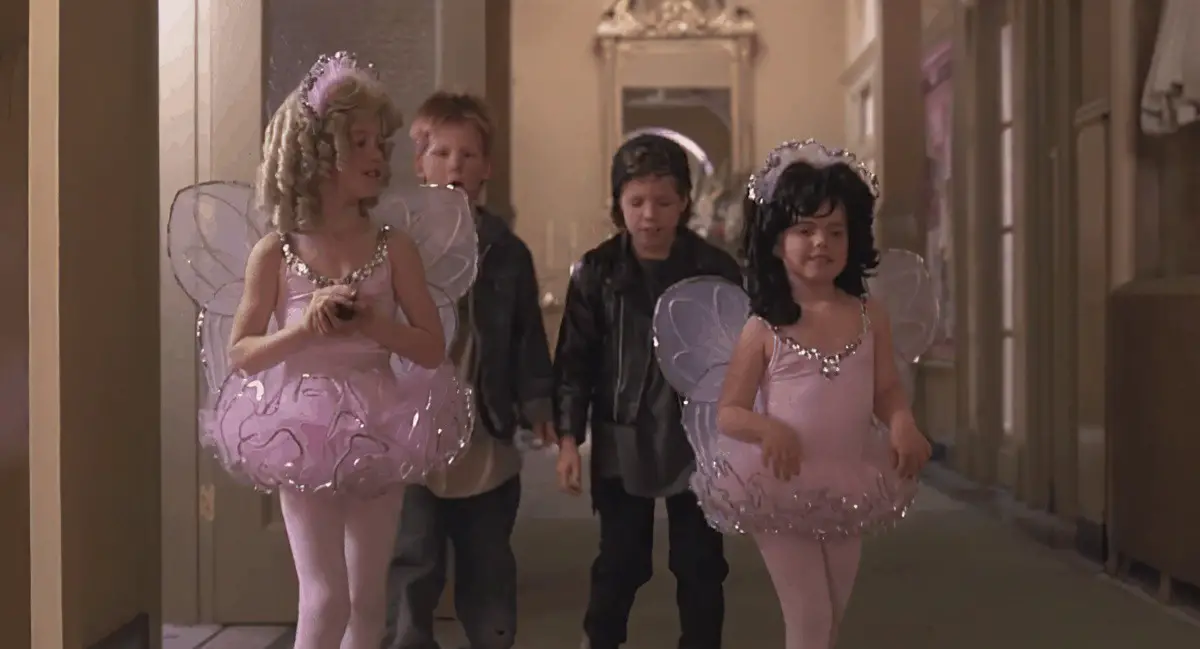
Coded as girls, Alfalfa uses this opportunity to big himself up with his love interest. The boys are ushered onto stage with all the girls, who have been assiduously practising. Naturally, the boys stuff up the dance, but this is seen as amusing and delightful by the adult audience.
Dressed as girls, these boys suddenly attract the sexual attention of boys. Fair to say, this franchise has not aged well. (I especially did not need that cameo of Donald Trump, especially the outtake of him spitting his popcorn kernels onto someone else sitting in the bleachers.)
A BUG’S LIFE (1998)
During the circus scene, one of the Fly Brothers says to Francis (thinking he’s a girl), “Hey, cutie! Wanna pollinate with a real bug?”
SHARK TALE (2004)
In this story there is a ‘sissy’ shark who at one point ‘dresses’ like a dolphin as a disguise, to his macho father’s chagrin.
SHREK 2 (2004)
This film is full of cross-dressing gags.
- the implication that Pinocchio likes wearing women’s underwear
- a throwaway line about the big bad wolf in Grandma’s nightgown being ‘gender-confused’
- a visual gag involving a deep-voiced male bartender in wicked-stepsister drag
THE LION, THE WITCH AND THE WARDROBE ( film 2005)
Patriarchal older brother Peter punishes Edmond by telling him he deserves to wear a fur coat for girls; subtext reading, Edmond has now been demoted for lying.
Sub-subtext reading, lying — like wearing fur coats — is a girly thing to do.
FANTASTIC MR FOX (2009)
We don’t actually see any ‘cross dressing’ in this film, but dressing as a girl is still used as an insult. From the script:
BEAVER’S SON (to Ash): We don’t like you, and we hate your dad. You’re too snazzy. You dress like a girl. You’re creative. Now grab some of that mud, chew it in your mouth, and swallow it.
(For many other reasons I believe the Wes Anderson adaptation of Fantastic Mr Fox is a film for nostalgic adults rather than for children themselves.)
TOY STORY 3 (2010)
When Barbie, dressed in Ken’s astronaut suit, gets Buzz’s instruction manual from the Bookworm he notices Barbie’s high heels and sighs disgustedly.
This hints that he believed Ken had begun cross-dressing, and that dressing as a woman is a tiresome thing.
In another scene in the vending machine, Ken claims that he’s not a girls’ toy, meaning he does not want the other toys thinking he’s gay/sissy due to being part of the Barbie franchise: Making fun of boys who transgress gender lines hurts kids. In Toy Story 3, Ken laments, “Why do people always call me a girls’ toy?”, and he’s laughed at for having “girl’s handwriting.” What the film is teaching here is that 1) girl’s toys and handwriting aren’t as good as boy’s toys and handwriting, and thus 2) girls, and feminine boys, just aren’t as good as masculine boys. This is called gender policing, homophobia, and misogyny. It hurts kids. And you know what? This joke wasn’t necessary. No one would have enjoyed Toy Story 3 one whit less if the homophobia was left out. You make people laugh in plenty of other wonderful ways in every movie — why do it at someone’s expense?
Bitch Flicks
THE PIRATES! BAND OF MISFITS (2012)
The rolling credits at the end of this film are accompanied by (omitted but not really omitted) scenes. “It’s not about the treasure,” says one of the pirates, “it’s about how you feel inside.” The Pirate Captain responds dismissively with, “You’re not a man disguised as a woman, are you?” Also: “Grow yourself a beard. It’ll make your face look less lumpy.”
(Something tells me the creators of this film weren’t thinking too hard about their script. At least they took out the bad-taste leprosy joke before the final cut. But was there a feminist in the room?)
THE RADIATOR SPRINGS 500 1/2 (2013)
At the beginning of this TV episode (part of the Cars franchise) a car gendered male called Mater is dressed as an Hawaiian hula girl. As part of his disguise he has coconuts placed on his headlights, an allusion to breasts similar to Mia and Tia’s headlights flashing in Cars.
BOSS BABY (2017)
The picture book by Marla Frazee does not have these problems. Sexism was inserted into the DreamWorks adaptation.
- Tim thinks it’s funny that the Boss Baby’s full name is Theodore Lindsey Templeton. Why? Because Lindsey is a gender neutral name. It is sometimes given to boys. It’s associated more commonly with girls.
- Later, it’s revealed that Tim’s full name is Timothy Leslie Templeton. Also hilarious. Again because Tim has been given a gender neutral middle name. It is sometimes given to boys. But is more heavily associated with girls.
- At Baby Corp, a lot of VR babies are walking around. Tim walks into a little girl and to the viewer it looks as if he is a boy wearing a dress. Boss Baby, voiced by Alec Baldwin, says, “Stop embarrassing yourself.” Why is it embarrassing to look like you’re wearing a dress? Because girls wear dresses and girls are stupid.
I think the writers knew that this was a problem. Instead of taking the horrible jokes out they turned the film into a circular story structure by suggesting that the same story was going to happen all over again, but this time to a girl and her little sister. This is faux gender equality which exists only on the surface. Too many people buy into it.
LAXMII (2020)
The film is a Hindi remake of the 2011 Tamil film Kanchana. Director Raghava Lawrence has been at the helm for both movies. Starring Akshay Kumar, the movie is about a transgender ghost taking revenge on a family and possessing the star character.
Obviously, just the premise is transphobic. The only trans character in the movie isn’t a person, just an evil, vengeful spirit. In addition, she’s being played by Kumar, a male actor. The movie is billed as a “horror/comedy,” and the preview does a lot with getting laughs from situations where Kumar’s character puts on a saree or acts in feminine ways, making the ghost’s gender the punchline of the joke.
The film goes further, though.
If you can stand it, read the rest at Out.com
As a trans person, you don’t transition to become someone else. You transition to stop pretending that you are someone else. There’s a huge difference.
@nonbinary_shapeshifter
GENDER INVERSION AS GAG IN MIDDLE GRADE LITERATURE
BARKING MAD BY TOM E. MOFFAT (2015)
Barking Mad features a ‘bitchy’, annoying, girly-swot teenage girl whose younger brother narrates the story of their body swap from his own close third-person point of view. The book begins in a very appealing way, with ‘mad professor’ granddad gone ‘barking mad’ after inventing a body swap device and accidentally inhabiting his dog’s body. The brother and sister find the machine, accidentally swap themselves, and now we have a Gender Bender story which actually kind of replaces the animal story I thought I was buying.
It is nearly an Obligatory Joke for a cross-gender body-swap couple to have some reaction of shock/disgust/surprise to the other’s genitalia. In the anime Your Name we have two unrelated strangers dealing with their new bodies whereas the sibling swap has an extra layer of built-in disgust due to the children being related. In Barking Mad, our boy protagonist is so disgusted at the thought of his older sister’s body that he holds on all day without using the toilet. We aren’t told how the sister dealt with her brother’s genitalia in the toilet because the story does not switch to her point-of-view.
When seen over and over again, this story of adolescent disgust directed towards female bodies — often, as in this story, because they’re related by blood, but sometimes as a way of showing the boy hasn’t reached manhood and is not ready for sex — I feel this trope has real-world implications for how society is already ridiculously coy (at best), disgusted (at worst) by womanhood. Even today, basics such as the clitoris are often left off diagrams when teaching female reproduction to adolescents, yet all genders will definitely be told about male masturbation and ejaculation.
I was already nervous about the way this body swap was going to be handled after one of the early jokes involves the humiliation of a police officer, who is down-troued in a slapstick joke. Not only does he suffer humiliation owing to the airing of his underwear — the underwear is specifically described as pink. Why? Everyone knows why, but it sounds worse when it’s put into words: Pink is so heavily identified with femininity that when men are associated with this colour they are associated with women and girls. This is humiliating for men precisely because femaleness is associated with lesser power. In this version of (toxic) masculinity, manliness is not the better flipside of ‘boyhood’, but of ‘womanhood’. This sort of humour, in which boys and girls are pitted against each other is still popular, no doubt about it.
David Walliams has sold millions of children’s books around the English speaking world doing very similar things. My eight-year-old daughter laughed when I read the joke. She, too, had already internalised this far more subtle form of sexism. (Update: They have since learned to read critically.)
The gatekeepers of children’s literature no longer accept black and white children pitted against each other, however subtle the joke, but blithely publish the gender equivalent.
BIG NATE SERIES BY LINCOLN PEIRCE
Taking just a single book in this series (Genius Mode, 2013), which I happen to have read due to my child getting it out of the library, a large proportion of the gags are gender inversion gags.
- Nate feels humiliated because the school photographer puts powder on his nose (which leads him to break out in a rash). The first half of that gag is supposed to be funny because boys aren’t supposed to wear make up.
- Nate hates figure skating. He is humiliated when his father retrieves figure skates when the most respect-worthy people at the rink will be playing the masculine-coded sport of ice hockey.
- It’s surprising Nate is such a raging femme phobic because his own father and role model is quite at home doing what he loves. The entire gag of one comic strip rests upon the image of Nate’s disgust at his father who is off to yoga. The father carries his yoga mat very much as if it’s a handbag. The gag would not work if the father was setting off to engage in a masculine-coded activity.
- A further underlying gag through Big Nate is that smartness and studying is a feminine-coded trait, to be avoided at all costs. A defender might argue that another boy character is into studying, and shown to be a success with girls because of it. But this boy is not the viewpoint character.
Do stories like Big Nate really make fun of the main character, or do they reinforce an existing cultural message that girl-coded activity is inferior, and boys must work hard to avoid it?
My answer is that it does both.
GENDER INVERSION AS PUNISHMENT IN REAL LIFE
Whether the pink clothing was designed as a punishment or not, note the context carefully:
Arpaio saved worse abuse for others. Those who were in full detention had to wear pink socks, underwear and flip-flops. They ate peanut butter and bread, and the only other meal they received was baloney and bread. They also had the option of “slob,” which was an unknown, disgusting substance that looked like some kind of thick stew and tasted like cardboard. (The poor people in the work furlough program who couldn’t pay for vending-machine food had no choice but to eat it.)
The year I spent in Joe Arpaio’s tent jail was hell. He should never walk free, Washington Post
In the story, this is the event which transforms the masculine prison culture into a kinder, softer one in which men are allowed to show their feminine side. In comedy, character transformation does often take place after ridiculous events. That’s part of the comedy. But as part of the wider culture of gender inversion as humiliation, I can’t find this gag genuinely funny.
BOYS DRESSED AS GIRLS AND THE TRANSGENDER COMMUNITY
When male characters dress as female characters in children’s films, they’re doing it as a kind of mask, in preparation for their ‘real’ nature being exposed in a comical exposure scene. This is a common gag in comedy — if the main plot rests on it, it’s called a transgression comedy. The world of children’s stories is yet to see many transgender stories.
However, we are starting to see a few transgender stories in entertainment for adults. While transgression comedies for children are not the same as transgender narratives for adults, there are clear parallels. I believe we should look to the transgender community to fully understand the implications of playing gender inversions for gags.
Trans Narratives is an organisation helping trans people share their stories. They have called for a boycott of cis-men (be they gay or straight) playing trans women on screen.
“Feedback indicates that most trans people are offended by Hollywood’s employment of cis men who put on a dress trying to imitate trans people. If it is no longer acceptable for white folks to play African Americans, American Indians, Asian Americans, why is it acceptable for men to play trans women?”
An admin of the page wrote in another: “As a trans woman, I know from personal experience that many gay men believe that trans women are really gay men who refuse to deal with being gay men. I’ve been told this to my face.“So perhaps the gay men who insist on ‘gay-splaining’ that Matt Bomer should be playing a trans woman just can’t get over the notion that trans women are in fact women, not gay men.” Another read: “On Trans Narratives I asked the trans community what they thought of cis men playing trans women. The vast majority of trans people say it exploits us. Don’t debate us! Don’t tell us it’s just a movie and these men are just acting. Listen to us! Listen to a mother of trans children.” — Pink News
Misogyny and homophobia in Avatar Extras. Boys dressed down as ‘girls’ for humiliation purposes is never funny due to its reliance upon a shared acceptance of misogyny (gender hierarchy) and homophobia. To a thinking audience, this SHOULD cancel out the humour of any awkward clownery.

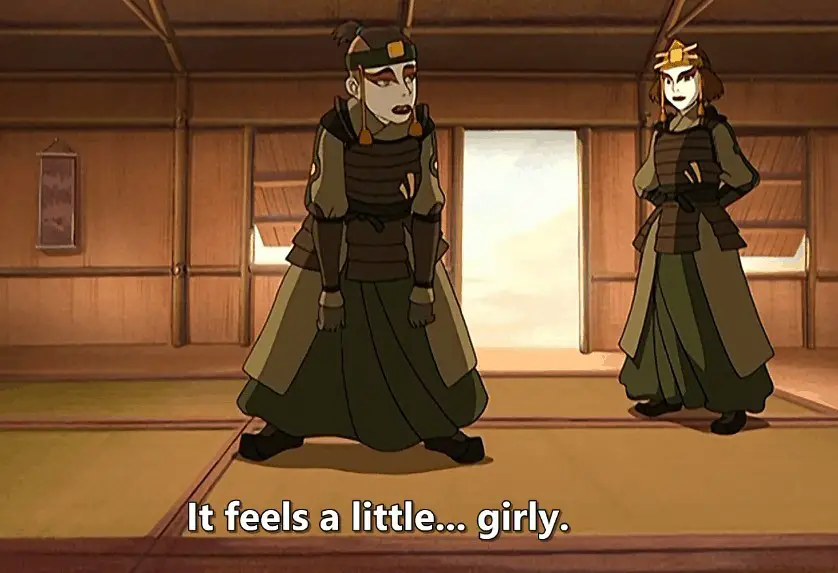
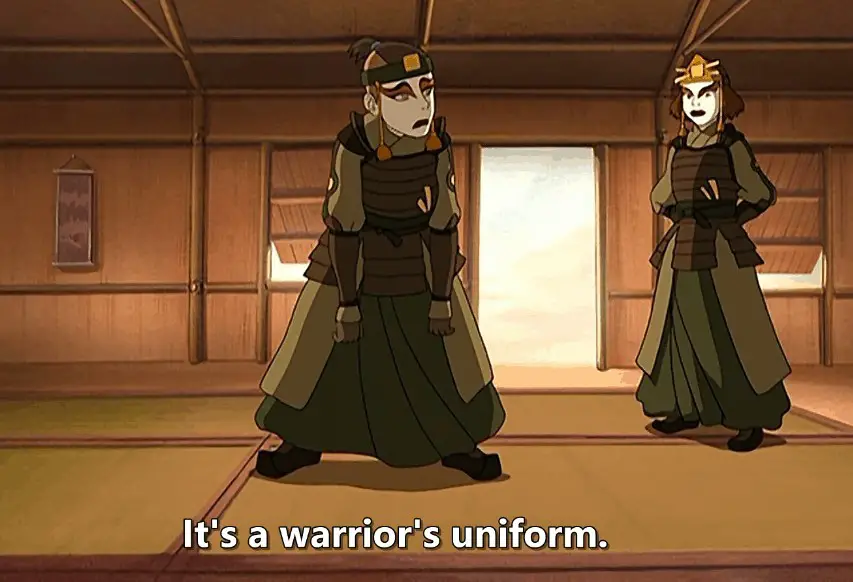

MALE VILLAINS CODED AS FEMME
Related to this is a kind of inverse, utilised to hugely problematic effect in Silence of the Lambs, for example.
When men are coded as femme (rather than necessarily ‘disguised’ as a woman) this signals a particular form of evil. We have to take into account the long tradition of designing villains to be visually femme-coded or queer-coded: visibly crossing the usual barriers between “masculinity” and “femininity” as a method of othering them and making them unusual and scary compared to the straight-laced, normative heroes.
The Afictionado
As examples, The Afictionado offers:
- Ursula from The Little Mermaid with visible eyeliner and angular, feminine shaped face
- Starscream from Transformers (with high heels built into his mechanics)
- Anansi from American Gods — slim, poetic, dapper.
Any male villain with the following characteristics fit this archetype:
- make-up, defined eyebrows, heavy eyelashes etc.
- high heels
- flowing capes etc. which could pass for dresses
- slim, androgynous bodies
- slick suits
- similarities to cats (which we tend to code as feminine)
- they use the ‘woman’s weapon’ of cleverness and speech
- they are shapeshifters, so you never know who they ‘really are’.
- charismatic cunning
This is all related to a loooong history of women as liars in dominant culture.
Although we don’t empathise with these characters, in stories we find them fascinating:
We all connect to that in-betweenness in our own ways, and enjoy living vicariously through these characters who take it to the extreme… and who can, perhaps, present that Otherness much more openly than we can.
The Aficionado
(There’s another word for ‘otherness’, haha. It’s ‘alterity’.)
I’m a woman! I’m glad my conception of masculinity is not centred on such a bowel-loosening fear of women and femininity that being compared to one is the very worst thing that could ever happen to me as a man.
John Scalzi, responding to twitter abuse comparing him to a woman
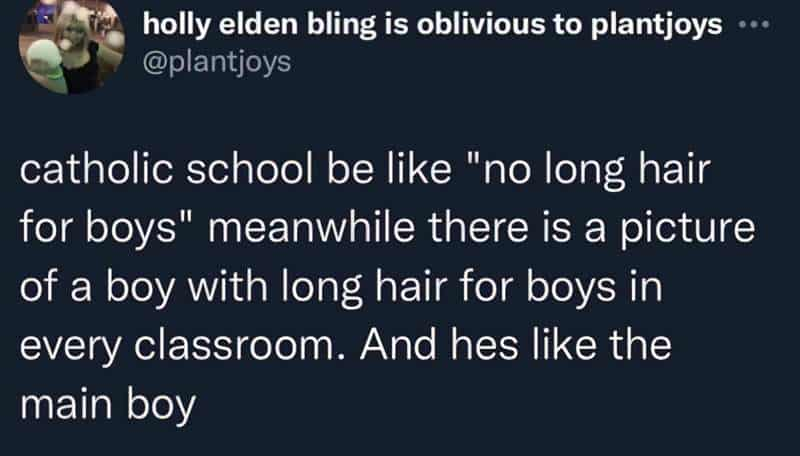
RELATED READING
- We’ve known for a long time that parents are more uncomfortable with gender-nonconforming behaviours in boys.
Header illustration by Theodore G. Haupt (1902-1990) 1929. Perhaps we’re supposed to code this picture as an illustration of an underwear thief. But there are other reasons why a masculo-coded individual may be travelling with lacy underwear.
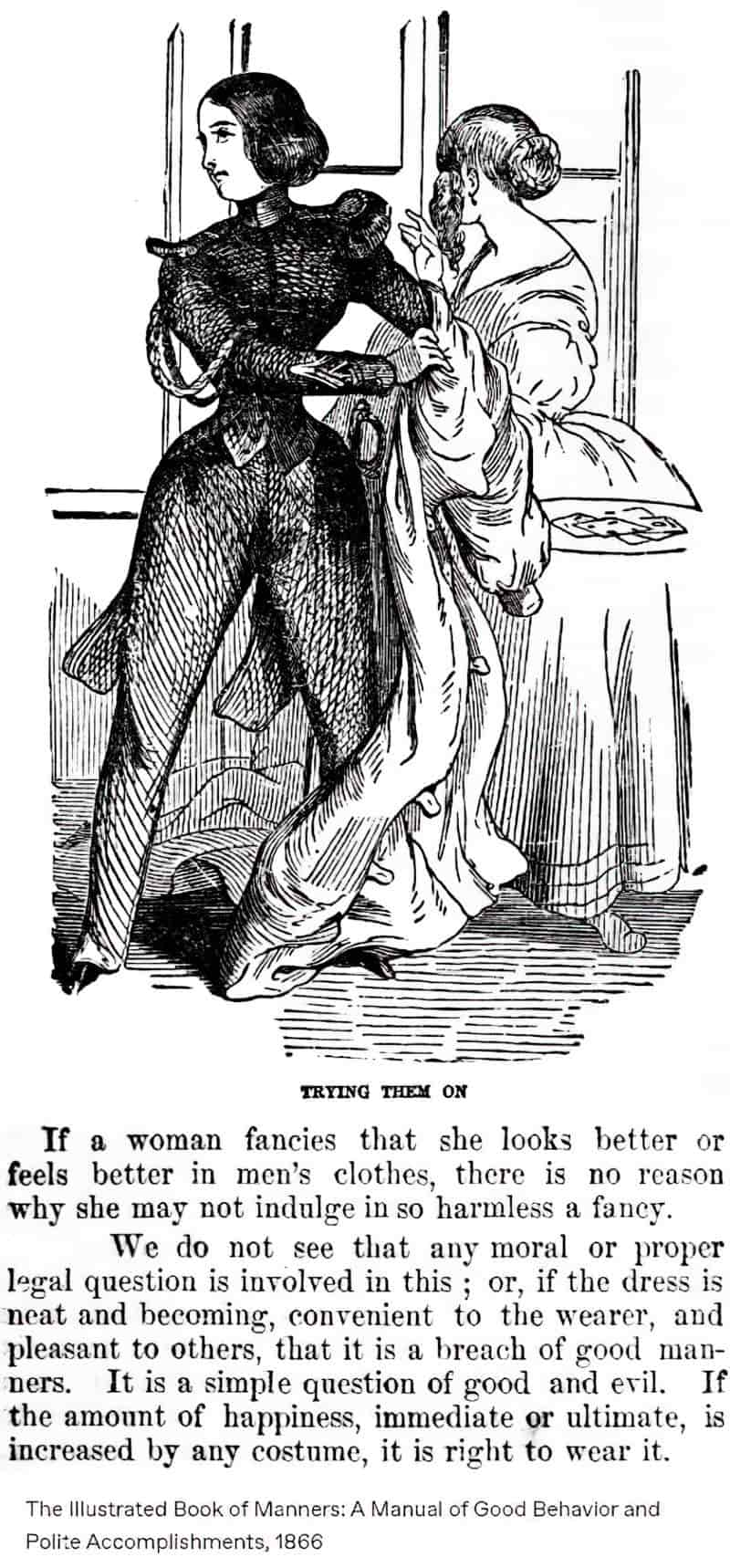
NO, GIRLS DON’T DRESS UP AS BOYS DUE TO MISOGYNY
“No wonder you’ve passed as a man! This is such an anti-woman society,” a lesbian friend told me. To her, females passing as males are simply trying to escape women’s oppression- period. She believes that once true equality is achieved in society, humankind will be genderless. I don’t have a crystal ball, so I can’t predict human behavior in the distant future. But I know what she’s thinking- if we can build a more just society, people like me will cease to exist. She assumes that I am simply a product of oppression. Gee, thanks so much.”
First, let’s talk about who can pass as another sex. My same friend reminds me periodically that she too might have passed as a men a century ago to escape women’s oppression. She stares right past my gender expression as she speaks. […] I don’t want to burst her bubble. Everyone deserves untrammeled dreams. But I want to tell her that, in the dead of winter, if she was bundled up against the cold, with a hood or hat covering her head, some man in a deli might call her “sir.” But could she pass as male on a board ship, sleeping with and sharing common facilities with her fellow sailors for decades and not be discovered? Of course, hundreds of thousands of women have dreamed of escaping the economic and social inequities of their lives, but how many could live as a man for a decade or a lifetime? While a woman could throw on men’s clothing and pass as a man for safety on dark roadways, could she pass as a man at an inn where men slept together in the same beds? Could she maintain her identity in daylight? Pass the scrutiny of co-workers? Would she really feel safer and more free? How could females have lived and been accepted as men without hormones or surgery? They must have been masculine; they must have been trans-gendered. If they were not, how could they pass? We don’t know how each of the thousands who passed from female to male over the centuries would define themselves today- whether as transgender or transsexual or drag or any other modern definition. The point is that their gender expression allowed them to transition. I just don’t believe that the debate about why “women pass as men” can be understood only in the light of women’s, or of lesbian and gay, oppression. It has to be viewed in the context of trans history in order to make sense.”
Look at George Sand, the nineteenth-century novelist. It’s true that she could not have published without a male nom de plume at that time. But if that’s all there was to her identity, why did she wear men’s clothing? Why was she attacked for masculine behavior? And if it was just a question of lesbian oppression, what was she doing in bed with Chopin? If passing from female to male is simply motivated by the need to escape lesbian oppression, then why have females who have passed as males chosen other men as lovers?”
“Finally, if so many females have passed as men only to escape women’s oppression, then why have so many males passed as women? While it is biologically easier for a female to pass as a young boy than for a male to pass as a woman, there are many, many examples in the modern era of those who passed from male to female.”
“We have not always been forced to pass, to go underground, in order to work and live. We have a right to live openly and proudly. When we are denied those rights, we are the ones who suffer that oppression. But when our lives are suppressed, everyone is denied an understanding of the rich diversity of sex and gender expression and experience that exist in human society. I have lived as a man because I could not survive openly as a transgendered person. Yes, I am oppressed in this society, but I am not merely product of oppression. That is a phrase that renders all our trans identities meaningless. Passing means having to hide your identity in fear, in order to live. Being forced to pass is a recent historical development. It is passing that is a product of oppression.
Chapter 11, Transgender Warriors by Leslie Feinberg

